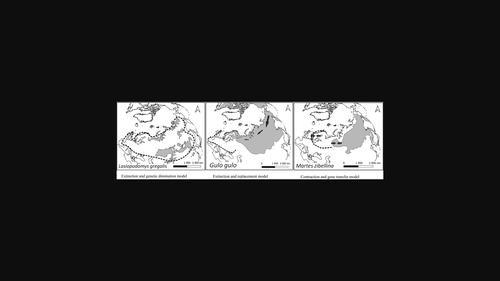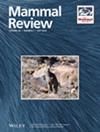Extinction and replacement events shaped the historical biogeography of Arctic mammals in Europe: new models of species response
IF 4.4
2区 生物学
Q1 ECOLOGY
引用次数: 1
Abstract
- The historical biogeography of the terrestrial mammals in Europe has been widely studied on the basis of fossil records and molecular makers. However, to date, only one model of species' responses to glacial–interglacial cycles during the glacial episodes of the Quaternary, especially during the Last Glacial Maximum, has been proposed: the ‘expansion-contraction model’.
- The ‘expansion-contraction model’ is more appropriate for thermophilous and temperate species than for Arctic species. We hypothesise that the responses of cold-adapted species to the temperature fluctuations during glacial cycles cannot be explained by this model.
- In this review, we synthesise and describe, for the first time, the historical biogeography of various cold-adapted terrestrial mammalian taxa (small mammals, herbivores, and carnivores) in Eurasia during the last glaciation (especially during the Last Glacial Maximum), and identify mechanisms underlying their response to glacier pulsation and severe climate fluctuations.
- We formulate the paradigm for the biogeography of cold-adapted mammalian taxa in Europe, and identified three response models to glacial–interglacial cycles: 1) ‘extinction and genetic diminution’ for Lasiopodomys gregalis, Dicrostonyx spp. and Lemmus lemmus, 2) ‘extinction and replacement’ for Alopex lagopus, Gulo gulo and Rangifer tarandus, and 3) ‘contraction and gene transfer’ for Lepus timidus and Martes zibellina.
- Knowledge of past biogeography is essential for understanding how cold-adapted taxa are responding to anthropogenic climate warming, and for on-going biodiversity and habitat conservation in the Anthropocene. There is no doubt that cold-adapted, Arctic species are suffering the most from global warming.

灭绝和替代事件塑造了欧洲北极哺乳动物的历史生物地理:物种反应的新模型
在化石记录和分子标记的基础上,对欧洲陆生哺乳动物的历史生物地理学进行了广泛的研究。然而,迄今为止,仅提出了第四纪冰期(特别是末次盛冰期)期间物种对冰期-间冰期旋回响应的一种模式:“扩张-收缩模式”。与北极物种相比,“膨胀-收缩模式”更适合于嗜热性和温带物种。我们假设冷适应物种对冰期温度波动的响应不能用这个模型来解释。本文首次综合和描述了末次冰期(特别是末次盛冰期)欧亚大陆各种冷适应陆生哺乳动物类群(小型哺乳动物、食草动物和食肉动物)的历史生物地理学,并确定了它们对冰川脉动和剧烈气候波动的响应机制。本文构建了欧洲冷适应哺乳动物类群的生物地理学范式,并确定了三种冰期-间冰期循环的响应模式:1)Lasiopodomys gregalis、Dicrostonyx spp.和Lemmus Lemmus的“灭绝和遗传减少”,2)Alopex lagopus、Gulo Gulo和Rangifer tarandus的“灭绝和替代”,3)Lepus timidus和Martes zibellina的“收缩和基因转移”。了解过去的生物地理学知识对于理解冷适应物种如何应对人为气候变暖,以及人类世持续的生物多样性和栖息地保护至关重要。毫无疑问,适应寒冷的北极物种受到全球变暖的影响最大。
本文章由计算机程序翻译,如有差异,请以英文原文为准。
求助全文
约1分钟内获得全文
求助全文
来源期刊

Mammal Review
生物-动物学
CiteScore
12.20
自引率
4.10%
发文量
29
审稿时长
>12 weeks
期刊介绍:
Mammal Review is the official scientific periodical of the Mammal Society, and covers all aspects of mammalian biology and ecology, including behavioural ecology, biogeography, conservation, ecology, ethology, evolution, genetics, human ecology, management, morphology, and taxonomy. We publish Reviews drawing together information from various sources in the public domain for a new synthesis or analysis of mammalian biology; Predictive Reviews using quantitative models to provide insights into mammalian biology; Perspectives presenting original views on any aspect of mammalian biology; Comments in response to papers published in Mammal Review; and Short Communications describing new findings or methods in mammalian biology.
 求助内容:
求助内容: 应助结果提醒方式:
应助结果提醒方式:


